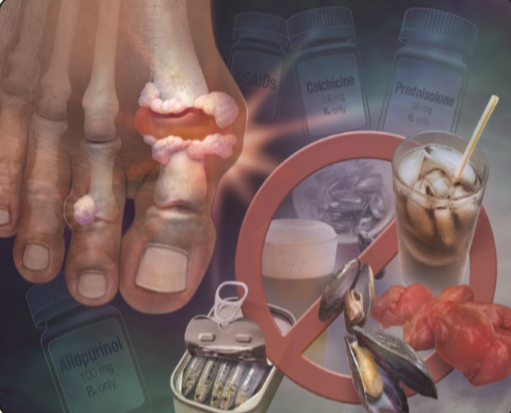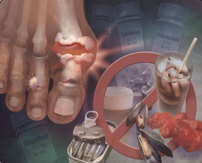
Do you have a painful swollen joint of your greater toe? If so, you might have gout! The odds of you having gout are up to six times greater if you are male. The percentage of people with gout at any one point in time is 3% to 6% in men and 1% to 3% in women. In 2015 and 2016, there were about four new cases of gout per every one-hundred people per year. This does not seem worrisome, but when we think of the size of the U.S. population being about 328 million, we begin to see just how common gout is.
 Gout most commonly presents as swelling, pain, and tenderness in the joint of the greater toe. Yet, up to 60% of the time the affected joint may appear on a different part of the foot or even the upper extremities. Some people may also have a nodule or bump under the skin. This finding is called a tophus and is typically located on the ear, pulps of the fingers or the elbow.
Gout most commonly presents as swelling, pain, and tenderness in the joint of the greater toe. Yet, up to 60% of the time the affected joint may appear on a different part of the foot or even the upper extremities. Some people may also have a nodule or bump under the skin. This finding is called a tophus and is typically located on the ear, pulps of the fingers or the elbow.
You may be wondering by now what exactly is causing the pain and swelling. Monosodium urate crystals are the answer! These crystals interfere with the joint environment and wreak havoc. There are several things that increase your risk for developing crystals in the joints. Eating certain foods that are rich in the chemical compound purine increases your risk for gout. Some purine-rich foods include anchovies, sardines, scallops, mussels, bacon, beef, liver, turkey, veal and venison. Drinking alcohol also increases your risk for gout. Beer is the worst when compared to wine and hard liquor. Sugar-containing products like soft drinks or any fruit juice also increase the risk of gout in men. Some medications may also increase your risk for gout.
Besides diet there are some medical conditions that can also increase your risk for gout. These include but are not limited to diabetes, elevated cholesterol, elevated triglycerides, obesity, menopause or kidney disease. Some ethnic groups are also at higher risk, in particular indigenous Taiwanese, Pacific Islander, and New Zealand Maori. Gout may start as early as age 20 but becomes more common with age, with the highest risk of presentation at and after 80 years old.
If you think you may have gout, do not hesitate to seek advice from your primary care provider or health care professional. We are here to provide guidance, testing as needed and prompt treatment. Your primary care provider will help exclude other conditions that may present similarly to gout such as an infection of the joint, an infection of the skin, autoimmune arthritis (from psoriasis or rheumatoid arthritis), sarcoidosis or arthritis of old age (osteoarthritis).
In situations where the diagnosis of gout is not evident, your primary care provider or healthcare professional might have to perform a joint fluid analysis. This procedure is not routinely needed but, in some situations, it might be needed to exclude certain conditions. Your primary care provider or healthcare professional will provide their expertise and guidance to help with this decision.
 Dr. Juárez is a resident physician who sees patients of all ages and provides obstetrical services at Lone Star Family Health Center, a non-profit 501©3 Federally Qualified Health Center operating facilities in Conroe, Spring, Willis, Grangerland, and Huntsville, and serving as home to a fully integrated Family Medicine Residency Program to increase the number of Family Medicine physicians for Texas and our community.
Dr. Juárez is a resident physician who sees patients of all ages and provides obstetrical services at Lone Star Family Health Center, a non-profit 501©3 Federally Qualified Health Center operating facilities in Conroe, Spring, Willis, Grangerland, and Huntsville, and serving as home to a fully integrated Family Medicine Residency Program to increase the number of Family Medicine physicians for Texas and our community.



